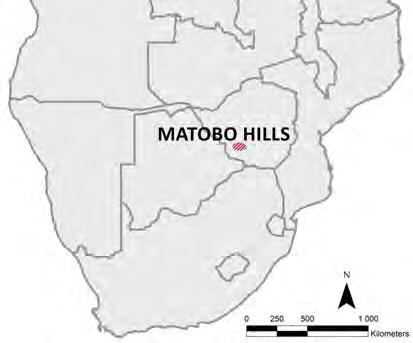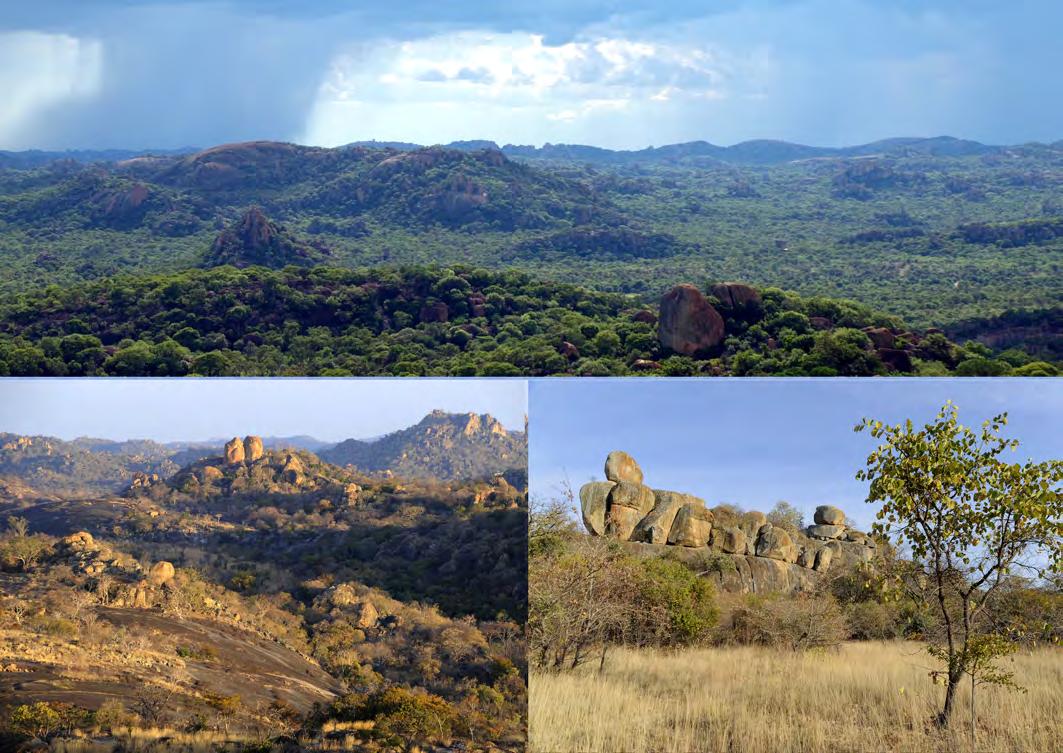
14 minute read
Matobo Rock Art in its Landscape. Understanding Role(s) of Rock Art in Later Stone Age Foragers Territoriality Léa Jobard
Matobo Rock Art in its Landscape
Understanding Role(s) of Rock Art in Later Stone Age Foragers Territoriality
Advertisement
Léa Jobard
Léa Jobard is a CNRS PhD student at TRACES laboratory (University of Toulouse) and at IFAS-Research (Johannesburg). She conducts her research under the supervision of François Bon and Camille Bourdier on the function of rock art in the territorial structuring of Later Stone Age communities.
As archaeology developed with new discoveries, it quickly appeared that similarities between the remaining artifacts found in sites separated by many kilometres were signs of recurrent visits by the same human group or of exchanges between different groups. In Southern Africa, settlement studies at all scales and based on different materials have flourished since the 1970s (Parkington, 1976). In the Matobo Hills, Nick Walker proposed a model of settlement patterns in the longue durée by Middle and Later Stone Age populations, mostly based on socioeconomic behaviour (Walker, 1995). However, knowing that rock art sites are highly significant for Southern African foragers (Deacon, 1988), we are led to wonder what role rock art played in the settlement pattern, what social function it had and if it changed through time – and how we can answer those questions. In this article, I will give a general overview of my PhD research, addressing each of these issues.
The Matobo Hills paintings and Nick Walker’s model
Located in Matabeleland South Province (Zimbabwe), a 2 000 km² granite massif forms the Matobo Hills. Erosion caused by the presence of many streams and rivers created a hilly landscape of valleys and inselbergs, kopjes, block fields, rock shelters and caves (Scharsich et al., 2017; Walker, 1995; Fig. 1 and 2). Nowadays, the climate is generally temperate, with a four-month rainy season followed by warm, then cold and dry seasons (Nhamo, 2012; Walker, 1995). Despite variations in time and space, rainfalls are generally higher in the Matobo than in the surrounding areas and many natural reservoirs keep water even after the end of the rainy season (Walker, 1995; Fig. 1). After the cold and dry conditions of the Late Glacial Maximum (23 000-18 000 BP), climate conditions gradually improved. The Younger Dryas event brought colder and drier weather between 12 700 BP and 10 200 BP (Chevalier & Chase, 2015). Then, from 8 500 BP, temperatures rose, reaching a maximum around 7 000 BP before decreasing, and rainfall constantly increased until 2 000 BP (Chevalier & Chase, 2015). Currently, the vegetation is typical of the Zimbabwean highveld, mostly covered with forest mixed with shrub and grassland, in contrast with dry savanna of the surrounding lowveld (Scharsich et al., 2017; Walker, 1995). Moreover, the alternation between alluvial valley and rocky hills creates a particular patched environment with a rich and diverse biodiversity not found in the lowveld around the Matobo Hills (Fig. 1). Past environment of the Matobo is poorly known, but it is trusted that it was as diverse as today (Walker, 1995). Since the Early Stone Age, human groups have visited the Matobo Hills and hints of their successive occupation are well preserved in many rock shelters (Pomongwe
Cave, Bambata Cave, Nswatugi Shelter, etc.). First noticed by geologists, this density of archaeological remains attracted a few researchers between the 1920s and 1980s. Amongst them, Nick Walker spent twenty years surveying a large part of the Matobo National Park and excavating several prehistoric sites. He noticed that in the area of Nswatugi Cave, where numerous shelters are available, only a third of them were used by foragers, suggesting that they carefully selected their sites (Walker, 1995). His rock art survey, as well as other researcher’s (Garlake, 1987; Cooke, 1963), showed a high variability on many levels: site dimension and morphology (from overhang to 10 meters wide shelter), altitude (from valley to hilltop), images composition (from a few to hundreds overlaid), colours (reds, violet, white and black), painting techniques (mono-, bi- or polychrome, outlined, striped), styles (realistic or schematic), motifs (many animal s p e c i e s , h u m a n s , p l a n t s a n d g e o m e t r i c f o r m s ) , archaeological context (from no associated activity to aggregation site).

N. Walker proposed a model of Later Stone Age (LSA) populations’ territoriality and how it changed through time (Walker, 1995). Before 9 600 BP, a few LSA groups visit wide shelters such as Pomongwe, only during the autumn, and then during the summer as well. Around 9 100 BP, foragers are present all year round and groups seem numerous considering the number of sites and
Figure 1: Landscapes of the Matobo Hills. Top: View on the Matobo National Park on a rainy day (User: Digr – CC BY-SA 3.0 - https://commons.wikimedia.org/); Bottom left: View from World’s View Hill; Bottom right: Balancing rocks (Gerhard Hubert – CC BY-NC 4.0 – https://global-geography.org/).

Figure 2: Various site’s morphologies and dimensions. Top left: View of Inanke Cave (image: C. Dudognon); Top right: View of Bambata Cave (image: C. Dudognon); Bottom left: View of Nswatugi Cave (image: C. Dudognon); Bottom right: View of Honey Hunter Shelter (image: C. Bourdier).

deposits dur ing this per iod. As Walker states, this hypothesis can’t be correlated with mobility patterns of Lowveld or Kalahari sites in surrounding vicinities as they are poorly studied. In the Matobo, different groups settle in a foraging range organised around one or two main dwelling sites and around smaller, more specialised sites. They increasingly assert their identity and territory according to stylistic differences between artifacts found in different sites. Concomitant with this regionalisation, most of the rock art is produced during this specific period, given the high quantity of ochre present in the deposits. Walker suggested that rock art was performed during group ritual practices in response to higher population density and stronger social structure (Nhamo, 2012; Walker, 1994). After 8 500 BP, and even after 7 800 BP when climate conditions deteriorated, the population density decreases while fewer and smaller sites are occupied. But during this same period, there is also evidence of a periodic aggregation of several groups. From 2 200 BP, some foragers start rearing sheep and making ceramics. Around 300 AD, farmers settle in the Matobo, paint rock art, and foragers are pushed back into zones less suitable for agriculture or cattle (Walker, 1994, 1995).
Walker’s model provides insight into reg ional settlement tendencies that could be efficiently reexamined and enriched with the study of rock art and its location in the landscape.
Environmental study of rock art
To understand the complexity of past communities – their social structure, their economy, their adaptation strategies, their relations with other communities, etc. – it is essential to investigate their territoriality: the social link between this community, its culture and the physical space where its activities take place (Delanda, 2006). This kind of study can be conducted at different scales, notably
the rock art of the hunter-gatherers in southern africa
at intra-site, local or regional scales (Hyder, 2004). Moreover, this concept of ter r itor iality does not necessarily refer to the western notion of property, where an individual or a group owns a homogeneous piece of land. Indeed, several ethnographic and ethnohistoric reports show that the idea of possession, territory or border can be quite different according to communities in Southern Africa (Smith & Blundell, 2004). A group’s territoriality is determined by the landscape in which they live. We refer here to Ingold’s definition of this notion: rejecting the idea of an outer physical space existing independently from human existence, he sees the landscape as an ensemble of entities which exist in relation to one another’s entities (Ingold, 1993). In other words, the landscape of a forager group refers to the physical world they inhabit, as they perceive, see and relate to it. To better understand, Ingold gives the example of borders: a river or mountain range is a border only if the people living around feel that it is one. As a complementary notion, the environment is similar to the landscape and puts emphasis on the processes between the elements of the world – whereas landscape focuses on the form (Ingold, 1993). Another useful concept to study human territoriality is the taskscape, a notion referring to the ensemble of relations (social, economic, spatial) between tasks done by a group, in which every task carried out by an individual makes sense cognisant of the tasks carried out by the community (Ingold, 1993; Robinson, 2010). As a task necessarily takes place in a chosen space – we choose, to a certain extent, what we do and where – taskscape is linked to the landscape. To understand past societies’ space organisation, we have thus to consider their taskscape and its relation to the landscape, through every archaeological ar tifact or activity remnant and palaeoenvironment analysis. Even if most settlement studies concentrate on socioeconomic activities (intra-site organisation, resource supplying strategies, group mobility, long-distance exchanges, etc.), more and more researchers investigate rock art through this concept of taskscape, as it is as much a task as any other actionable event (Robinson, 2010; Wienhold & Robinson, 2017). Rock art has the advantage of being non-portable, and we find it in the exact same place where it has been produced and used, contrary to other artifacts (Nash & Chippindale, 2004). Thanks to ethnohistorical records, we know that painted places were h i g h ly s i g n i f i c a n t f o r f o r a g e r s , w h o k n ew t h e i r environment perfectly (Deacon, 1988). Settlement studies tend to undervalue the influence of parameters such as the territoriality of other groups, symbolism, danger or superstition linked to places, over the presence or absence of resources (Wheatley & Gillings, 2002). Economic, social and symbolic realms should not thus be separated, but integrated into the same studies in order to offer a r ic her and more comprehensive vision of taskscape, social relationships, and ideological behaviours (Hyder, 2004; Robinson, 2010). In a diachronic perspective, when searching for causes of change or long lasting-practices, it is relevant to include rock art as it plays a significant social role and is ruled by cultural standards (Heyd & Lenssen-Erz, 2015). Rock art c o u l d b e p a r t o f a d a p t a t i o n s t r a t e g i e s t o n e w environments or social contexts (McDonald & Veth, 2006) whilst, possibly, the economic system remains the same through time, suppor ting the necessity for researchers to cross every archaeological domain.
Environmental study of Matobo Hills’ rock art
In Matobo Hills, where some elements to understand settlement patterns are already available but do not take into account the hundreds of LSA rock art sites, it seems necessary to make an environmental study of rock art. Indeed, analysing the choices performed in rock art sites, suc h as the location or the iconog raphy, enable investigation of: (1) their socio-cultural functions (ritual, identity, pedagogic, etc) as the iconographic and topographic variability suggests diverse functions (Lenssen-Erz, 2004); (2) the role of rock art in organising space, and structuring territory (Lenssen-Erz, 2004), a question usually explored through an economic angle, in order to propose a multi-proxy vision of the social geography of these groups; (3) the evolution of those territorial dynamics through time and the agents of continuity or change, especially at
unstable climate periods in order to test the adaptation strategies of the foragers. In order to address those issues, our PhD research includes different scales of analysis: the images, the site and the landscape (Hyder, 2004). The first objective is to set up a database, including information about paintings (theme, style, technique), suppor t (place and rock attributes), archaeological context (artifacts found in the deposit, other activities remnant, possible site use, dates), physical characteristics of the site (topography and geomorphology), and its place in the landscape (altitude, accessibility, view from and visibility of the site, notable elements of the landscape). This database is linked with a geographic information system (GIS) that enables us to easily visualise and analyse space data (for example, viewshed, network modelling; Wienhold & Robinson, 2017). Data is collected from unpublished documents by previous researchers, such as Nick Walker, partly curated by the Zimbabwe Museum of Human Sciences (Harare) a n d t h e Z i m b a b we M u s e u m o f N at u r a l H i s t o r y (Bulawayo). In order to test the relevance of the results, a control sample, constituted of unpainted rock shelters, will be recorded and analysed through the same criteria. Based on MATOBART chrono-stylistic sequencing, each site will be attributed to one or several chronological phases, assuming that the sites offering similar themes, styles, and techniques are more or less contemporaneous. From statistical analyses of the database and GIS processing, such as viewshed or least cost path calculation, the second objective is to highlight the main selection criteria for a site, and to find out if some images, or associations of images, are linked with some particular elements of the site, landscape or taskscape. We also plan to study networks between rock art and any other archaeological sites, how they work together as a system and assess socio-cultural function(s) of rock art sites (Lenssen-Erz, 2004). Our third goal is to compare the results in diachrony (chrono-stylistic phases), analysing variability of site physical cr iter ia and networks through time, and determining which are the elements of stability or change. Finally, our last objective is to compare our model with climate change in eastern Southern Africa, questioning change or stability agents at stake in rock art use. As a conclusion, this research has a strong conceptual ambition and is focused on a spatial and interdisciplinary approach confronting rock art, socio-economy activities and environmental conditions. Hopefully, in the future, i t w i l l p rov i d e a m o re dy n a m i c a n t h ro p o l o g i c a l perspective on the production and use of images within forager societies.
Bibliography
CHEVALIER, M., & CHASE, B. M., 2015, “Southeast African Records Reveal a Coherent Shift from High- to Low-Latitude Forcing Mechanisms Along the East African Margin Across Last Glacial–Interglacial Transition”, Quaternary Science Reviews, 125, p. 117-130. COOKE, C., 1963, “The painting sequence in the rock art of southern Rhodesia”, South African Archaeological Bulletin, 18(72), p. 172-175. DEACON, J., 1988, “The Power of a Place in Understanding Southern San Rock Engravings” World Archaeology, 20(1), p. 129-140. DELANDA, M., 2006, A New Philosophy of Society: Assemblage Theory and Social Complexity, London, Bloomsbury. GARLAKE, P., 1987, The Painted Caves, Harare, Modus. HEYD, T., & LENSSEN-ERZ, T., 2015, “Art, Rock Art and Climate Change”, in B. PUTOVÁ & V. SOUKUP (eds), The Genesis of Creativity and the Origin of the Human Mind, Prague, Karolinum Press, Charles University, p. 260-270. HYDER, W. D., 2004, “Location Analysis in Rock Art Studies”, in C. CHIPPINDALE & G. NASH (eds), Pictures in place: the Figured Landscapes of Rock-Art, Cambridge, Cambridge University Press, p. 85-101. INGOLD, T., 1993, “The temporality of the landscape”, World Archaeology, 25(2), p. 152-174. LENSSEN-ERZ, T., 2004, “The Landscape Setting of Rock Painting Sites in the Brandberg”, in C. CHIPPINDALE & G. NASH (eds), Pictures in place: The Figured Landscapes of Rock Art, Cambridge, Cambridge University Press, p. 131-150. MCDONALD, J., & VETH, P. M., 2006, “Rock Art and Social Identity: A Comparison of Holocene Graphic Systems in Arid and Fertile Environments”, in I. LILLEY (ed.), Archaeology of Oceania: Australia and the Pacic Islands, Oxford, John Wiley & Sons, p. 96-115.
the rock art of the hunter-gatherers in southern africa
NASH, G., & CHIPPINDALE, C., 2004, The Figured Landscapes of Rock Art: Looking at Pictures in Place, Cambridge, Cambridge University Press. NHAMO, A., 2012, Characterizing Hunter-Gatherer Rock Art: An Analysis of Spatial Variation of Motifs in the Prehistoric Rock Art of Zimbabwe, Ph.D. Thesis, Harare, University of Zimbabwe. PARKINGTON, J., 1976, Follow the San: An Analysis of Seasonality in the Prehistory of the South Western Cape, Ph.D. Thesis, Cambridge, University of Cambridge. ROBINSON, D. W., 2010, “Land Use, Land Ideology: An Integrated Geographic Information Systems Analysis of Rock Art Within SouthCentral California”, American Antiquity, 75(4), p. 792-818. SCHARSICH, V., MTATA, K., HAUHS, M., LANGE, H., BOGNER, C., 2017, “Analysing land cover and land use change in the Matobo National Park and surroundings in Zimbabwe”, Remote Sensing of Environment, 194, p. 278-286. SMITH, B., & BLUNDELL, G., 2004, “Dangerous Ground: A Critique of Landscape in Rock-Art”, in C. CHIPPINDALE & G. NASH (eds), Pictures in place: The Figured Landscapes of Rock-Art, Cambridge, Cambridge University Press, p. 239–262. WALKER, N., 1994, “Painting and ceremonial activity in the Later Stone Age of the Matopos, Zimbabwe”, in T. DOWSON & D. LEWISWILLIAMS (eds.), Contested images: Diversity in Southern African Rock Art Research, Johannesburg, Witwatersrand University Press, p. 119-131. WALKER, N., 1995, Late Pleistocene and Holocene Hunter-Gatherers of the Matopos, Uppsala, Societas Archaeologica Upsaliensis. WHEATLEY, D., & GILLINGS, M., 2002, Spatial Technology and Archaeology. The Archaeological Applications of GIS, LondonNew York, Taylor & Francis. WIENHOLD, M. L., & ROBINSON, D. W., 2017, “GIS in Rock Art Studies”, in D. BRUNO & I. MCNIVEN (eds.), The Oxford Handbook of the Archaeology and Anthropology of Rock Art.










